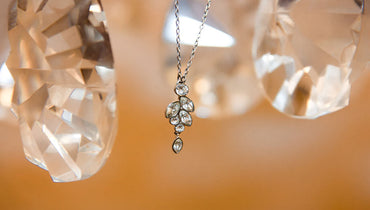Do not wear fine jewelry to the beach. Sand and saltwater can scratch and erode the finish and polish of gemstones and soft precious metals.
Do not expose jewelry to chemicals and do not wear while swimming. Chlorine, harsh detergents and other chemicals can erode the finish or cause worse damage. Gemstones and pearls can be ruined in a split second if exposed to chemicals or harsh cleaners. Pearls and other organic gems are damaged by chlorine pool water. Even gold can become brittle if exposed to small amounts of chlorine and bleach over time, causing breaks and loose prongs.
All gemstones can be damaged, even diamonds. Diamonds are hard, but they can get marred, scratched, chipped and cracked from exposure to chemicals, high heat or trauma such as dropping, banging, rough handling or harsh treatment. Even with proper care, mishaps occur.
Fancy black diamonds by nature can be more brittle than white diamonds. The intensely vivid black color of fancy black diamonds is produced by trace elements in the crystalline structure. Although beautiful, it is these very impurities that create a more brittle stone.
Do not wear fine jewelry in the shower or hot tub.
Take extra precautions with fine jewelry if you enjoy an active lifestyle. Do not wear fine jewelry while playing with children, gardening, sports and exercise, or doing household chores, especially washing dishes, cleaning making beds or doing repairs, etc.
Be careful not to catch or pull fine jewelry - it can break. When dancing or bending, long strung jewelry can get pulled and break. If jewelry catches on clothing, a snag can tear the cloth and break the jewelry. Hair is strong and can break jewelry when tangled. Combing or brushing hair can snag and break necklaces. Rings and bracelets can stretch or break from digging around in a handbag, drawer or file cabinet.
Put jewelry on after dressing, and only on clean dry skin. Soap, makeup, powder, hairspray, perfumes, body lotions and oils can dull or cause worse damage to gemstones and pearls. Over time, even body oils and perspiration can erode fine jewelry.
To avoid lost earrings, wear stoppers on earring wires and tight friction earring backs with post earrings. If you lose earring backs, purchase a suitable replacement from the place of purchase or at your local jewelry store - do not use an ill-fitting back.
Make sure clasps are secure. Unsecured or improperly attached clasps, and broken or weak clasps, are a major cause of lost jewelry. With respect to strung jewelry, make sure to hold only the ends of the clasp when taking off or putting on - avoid handling any French wire covering stringing material at each end of the clasp; it can fray.
Do not leave jewelry sitting on sinks, tables or countertops. Jewelry can disappear or be forgotten if not stored in its proper place. Rings are often lost when they are taken off to wash hands or do dishes. Place rings in ring holders placed around the house, but especially by the bed and in bathrooms and kitchen.
Keep Jewelry away from light. Sunlight is a form of radiation. White diamonds and most colored stones are immune to the effects of light. However, some popular gems fade if exposed to light for extended periods, including kunzite, amethyst, brown topaz, pink conch-shell (cameos), dyed pearls, dyed lapis and dyed jadeite. So do not store jewelry in display windows or near bright halogen lights.
Keep Jewelry away from Heat. Heat can change a colored gemstone’s color. A jeweler’s torch can change the color of aquamarine, topaz, jadeite, lapis, amethyst, tourmaline, turquoise and zircon. A jeweler’s torch can damage liquid-filled gems and crack opals. Also, jewelry repairs can cause thermal shock damage to colored stones such as tanzanite, peridot, opal and others. Organic gems like pearls, shell, coral, ivory and amber, as well as porous inorganic gems like opal, lapis and turquoise, are very easily heat damaged at even relatively low temperatures. Accordingly, when having jewelry repaired, it is recommended to use experienced professionals.
Storage near house heat vents can easily remove the natural moisture that some gems need to maintain their beauty, such as pearls and opals. Pearls can dry out, crack and discolor from excess heat. Opals turn white or brown, develop tiny cracks from moisture loss (called crazing) and might lose their play-of-color (fire) if exposed to excessive heat. Dry storage can be just as damaging for these gems. Accordingly, do not store jewelry near heat sources and do not store pearls or opals in a safety deposit box or safe.












hartlyn
such a useful article. thank you